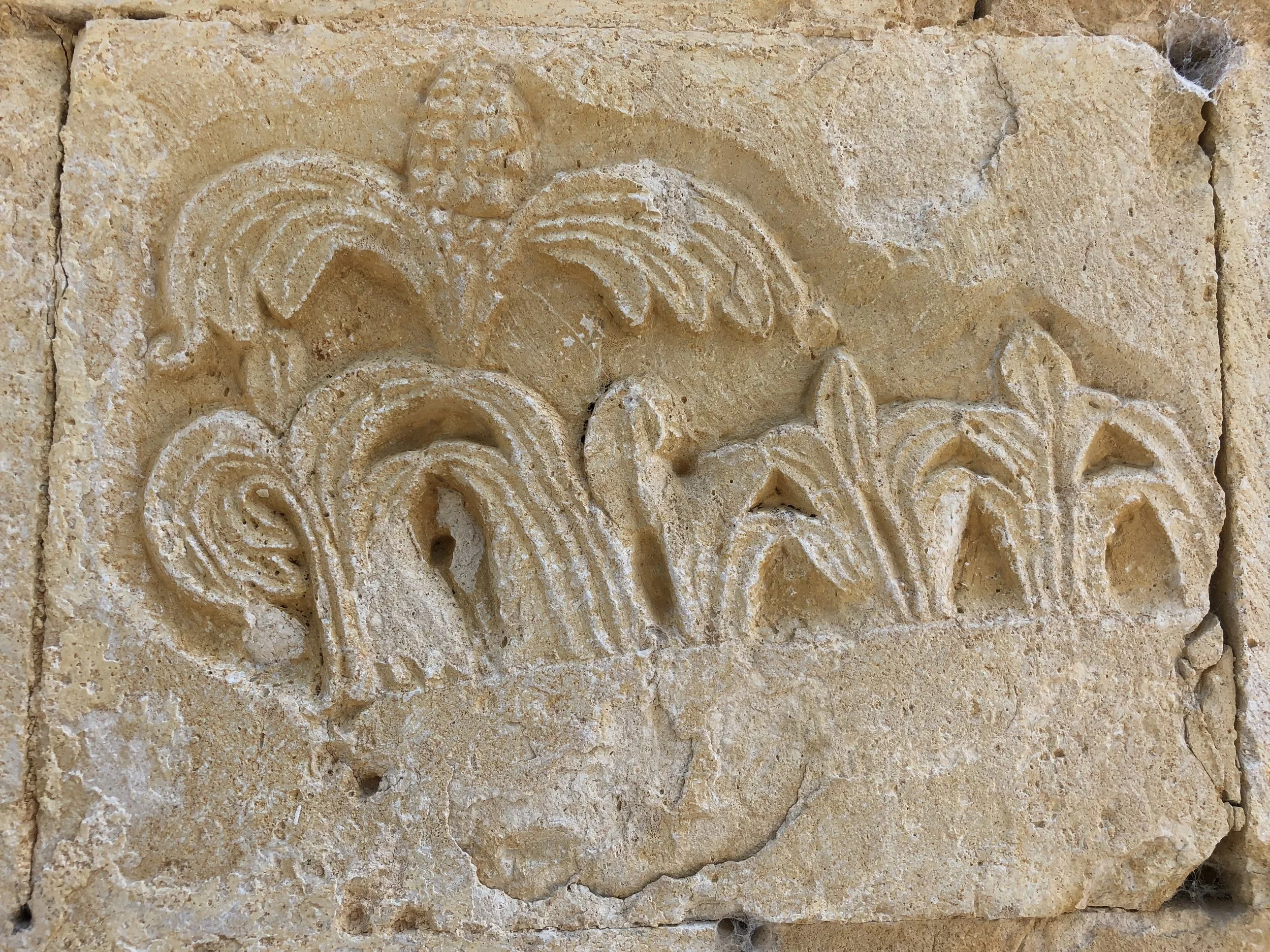Hercules, the lion and the corn
A sculptured relief of corn (maize)
The two lions look terrified, sitting as they are on the chancel steps. Their eyes are stretched wide, their chins angled upwards, their mouths open in a silent howl of fear. Incongruously, two spider plants in pots are on their backs.
There are many such buildings as this across southern Europe; a place of simple white stone surrounded by trees, and a little patch of grass by the south wall, where one can park a car. Here deep in the mountainous heart of Abruzzo, in the church of St. Thomas, the nave is sided by two aisles separated by square columns. The walls are unadorned save for a few primitive paintings of saints, one of whom is St Christopher who is mid-stream carrying an infant Christ. His foot has just missed stepping on a fish, which is grimacing as it swims away in fright. On another column Jesus, still with holes in his hands, is greeting the poor who crowd round him open-mouthed. Another shows the Passion.
At the eastern end, there is an apse where light beams through the small plain glass windows. Dust motes play in the shafts as they lengthen along the nave which slopes upwards towards the chancel steps. At the foot of these steps are the two stone lions squat on either side of the chancel steps. You can imagine the mason carving them, having never seen a lion and being instructed by someone who thought he might have done. ‘No, no you need to add more hair here, like a beard……’ The result is more mythical beast than lion.
At the crest of the steps, a narrow passage leads down into the dark and damp crypt where there is a spring. The walls drip with sanctity as well as water. Here in the bowels of the earth, Hercules, the god of springs, travellers and shepherds was worshipped 2,000 years ago. Centuries later, someone saw the Archangel Gabriel in this place and so a church was built where a temple once stood. Any magic could happen here. In the profound, centre-of-the-earth silence you hear the spirits move.
Outside in the bright light of mid-summer, the cicadas sing. Above the west door, a frieze shows the seated Christ surrounded by his disciples. They are alive in stone - chatting, looking bemused, smug, vexed. A couple are lost in thought, two are arguing. John, on the right of Christ has one eye-brow raised as if to say, ‘Really’? The scene could be any crowd of men, in any market place.
Draping down the stone columns on either side of the door are carved friezes of flowers and leaves of vines, and oak and figs. There are dragons too, chewing on stems and alaughing Green Man. But it is the horizontal frieze that we are here to see, for as you stand looking at the door, on your left towards the end of the wall, beyond the face of the ‘Green Man’, you’ll see a carving of maize.
You see the broad leaves of the plant drooping down, which they do in the heat of a summer’s day. You see the husks unfolding around the cob which is encircled with its seeds. It is a very fine and accurate carving. Anyone can see it’s maize. But there’s a problem here; the church was built in 1202 and maize was not known to Europe for another 300 years. No-one seems to question it. The few guides and texts on the church blandly remark that, ‘Another tile shows a cob in a row of corn’. As if this cob of corn was the most normal thing for a medieval stonemason to carve.
There is only one other known example of medieval maize in Europe and that is in Rosslyn church near Edinburgh, Scotland. No-one can explain that either. Not even Google knows, which in this modern age, is quite the thing.
No wonder the lions look terrified. Supposing - I imagine them thinking in the silence - supposing someone finds out that Columbus and Vespucci were not the first Europeans to land on those shores, and that it was the Greeks and the Phoenicians who had voyaged to American shores and that Europeans have been eating maize for centuries.
Bloody terrifying mate, they don’t like being wrong those humans, do they?
(https://www.iluoghidelsilenzio.it/chiesa-di-san-tommaso-becket-caramanico-terme-pe/),
Are you able to shed any further light on this mystery? Please use the comments section below to feedback any ideas that you may have.







